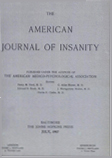THE INSANE PSYCHONEUROTIC
Abstract
The first point of interest lies in the differentiation of psychoneurotic from psychotic states. In almost all of the cases presented the diagnosis is rather perturbing. Indeed, in some it appears rather clearly to be other than psychoneurosis. Yet in most cases the state seems to be what we call psychogenetic in origin, and there are many symptoms of a psychoneurotic nature.
It is very difficult to define simply and accurately the differences between psychoneurosis and psychosis. In both the symptoms may be of the same type—pains, somatic ideas, emotional and ideational difficulties. The great outstanding difference seems to be that the psychoneurotic resist the ideas, where the psychotic accept the ideas, incorporate them into the personality and elaborate them. There are also fatigability, sensitiveness and worrying as symptoms of the psychoneurotic state, which are not usual in the psychoses. It is readily seen that the border line is tenuous and decision often difficult. In such cases the reaction to suggestion and explanation may be very important in determining the true diagnosis. Such suggestion is often only temporarily accepted even by the psychoneurotic, so that this is not an infallible guide to correct diagnosis.
Most of these patients are obviously insane in the sense earlier given. Such patients as Case I (suicidal attempt); Case II (successful suicide) ; Case III (dementia præcox type of incorporation of ideas) ; Case IV (depression causing inability to care for self); Case VII (seclusion, suicidal attempts); Case IX (somatic delusions ?, psychosexual disturbance); Case X (attempts at suicide, agitation); are clearly in need of mental hospital care and treatment, for their own protection and in the attempt to alleviate the condition. Such cases are not suitable for out-patient treatment. Yet with the exception of Case III, Case VII and Case X, the symptoms are certainly those of a psychoneurosis.
Neurotic persons are especially likely to be thrown off balance under external stress and strain. This was true in Cases II, III (?), IV, V, VI (?), VIII, IX (?). In Case III the cause possibly lay in the distasteful work and the reaction to masturbation. In Case VI the external stress seemed to be related to a cause for depression, usually the death of a loved one—which brought up the vicious circle of ideas regarding her own death. In Case IX the cause is not quite so clear, and here, furthermore, the ideas are more incorporated into the personality. In the other cases the cause seems quite clear. In Cases I, VII and X the external cause is not so apparent. In fact, the exact cause does not always clearly appear. This, of course, is more like the origin of psychosis.
Thus, Case I seems possibly associated with alcohol (involution ?); Case VII with hypertension, and some organic brain lesion (type not clear); Case X with constitutional inferiority, hypertension and involution—all of which are factors which usually do not produce states of this sort, at least in our experience. Promptly the question is raised as to the relation between these possible causes and the observed state. But it does not seem that we have progressed far enough in etiological investigation, either psychic or organic, to do more than note the associations in these cases and to await the results of therapy. There is no a priori ground for believing that a particular cause is necessary, providing that the soil be right. We could phrase it thus: Any cause on particular soils, or particular causes on any soil— although this goes somewhat too far, it roughly approximates the truth.
Accordingly it appears that differential diagnosis of psychoneurosis versus psychosis is not always easy; that external and internal causes may produce much the same state; that some psychoneuroses (symptomatically) run a manic-depressive course; that psychoneurotic symptoms may occur as the prodromal signs of dementia præcox; that psychoneurotics not infrequently commit suicide; that many are insane; that such causes as alcohol and arteriosclerosis may operate to produce a syndrome not to be distinguished from psychoneurosis.
Access content
To read the fulltext, please use one of the options below to sign in or purchase access.- Personal login
- Institutional Login
- Sign in via OpenAthens
- Register for access
-
Please login/register if you wish to pair your device and check access availability.
Not a subscriber?
PsychiatryOnline subscription options offer access to the DSM-5 library, books, journals, CME, and patient resources. This all-in-one virtual library provides psychiatrists and mental health professionals with key resources for diagnosis, treatment, research, and professional development.
Need more help? PsychiatryOnline Customer Service may be reached by emailing [email protected] or by calling 800-368-5777 (in the U.S.) or 703-907-7322 (outside the U.S.).



